| By: Paul S. Cilwa | Viewed: 4/20/2024 Posted: 3/27/2010 |
Page Views: 1195 | |
| Topics: #VerdeHotSpring #VerdeRiver #Arizona #Camping #Photography | |||
| The time I failed to reach Verde Hot Spring due to a river swollen from winter rains. | |||
This weekend's trip to Verde Hot Spring got cut short due to the fact that the Verde River is in flood season, unusually high because of all this winter's rains, and I couldn't cross it to get to the spring, which is my main reason for going. Still, I got some interesting photos of the river running so much higher than I've seen it before, so I thought I'd share them.
The adventure starts at Childs Campground, where normally, there are only a few campsites directly on the river. But the high water took out a lot of baby cottonwoods, creating new riverfront property. I got to camp almost on the water's edge.
My friends, Eddie and Carl, had the site next to mine. Here's Carl relaxing with the swollen river running behind.
Considering that I got there Friday night in March, I was surprised how many campers were already there. Here's someone who must have been worried the river was still rising, else why pitch their tent where the view of the abandoned power plant is clearer than that of the river?
As I've described previously, Childs, a hydroelectric plant that generated electricity from water rushing from Fossil Creek to the Verde River, was shut down about 10 years ago and the diverted flow from the creek turned off. Thus the cottonwoods, which had grown all those years from the leftover flume water, died off. Slowly campers are cutting down the dead trees and burning them for firewood. Some of the trunks are too big to haul away, however.
On my first camping trip here two years ago, I drove between these two trees and knocked off one of my side mirrors. I parked beyond the bushes, now on an island, and I wasn't on the edge of the water at all. If my car were there now, it would be underwater.
In addition to raising the river, the abundant rains this winter have produced a particularly exuberant crop of wildflowers, prettying up even the power plant's skeletal remains.
The first part of the hike to the river crossing, passes the foundations of the homes of the power plant workers. The occasional dead cottonwood in what had been a yard suggests that they had been watering their yards (perhaps to grow lawns?) up to a decade ago.
I don't know if the bee hives are still in use; I imagine they are, by bees, even if no apiarists are managing them any more.
Strolling along here provides plenty of views that explain why this area was underpopulated, even in the Native American days. Its beauty is sere, and hiking here without even the rough road built for the power plant would be quite a challenge.
Along the river, of course, the trees are healthy and green.
I had never seen cows here before, but obviously they'd been drawn to the lush vegetation near the river. When a few were disturbed, they bounded up the hillside like mountain goats.
As crude as it is, I was still surprised to see the "road" had been washed out at one point by water flowing from the side canyon. This was no problem to me on foot, of course. But it still points out how fragile are the works of man in the face of Nature.

Here's the place we normally leave the road and cross a gravel-and-lava bar, then stroll through a stand of aspen, to the narrow, shallow spot where the river can most easily be crossed. The bar was now a fork of the river! And the trail through the aspen was completely flooded.
Just upstream of the usual crossing spot is a pond into which the Verde flows, and immediately drains. Because it is wide and deep, it usually calms the current and is a quiet place to get a cool swim before or after the hot spring experience. I thought I might be able to swim across at that point, but in this new configuration, the current didn't seem to be slowed at all.
And the crossing itself? Not a crossing any more. I'll have to wait for the drying of summer, maybe May, before trying for Verde Hot Spring again.
Since I didn't go to the spring, I tried walking a little farther down Childs Power Road. It doesn't go much farther, or didn't today as it headed directly into the water. Looking back from there, it looks like a 4-wheeler's dream.
I ate lunch and took a nap before striking camp. On the way up the hillside, back to civilization, I got the best view of the hot spring I was going to get on this trip, thanks to a very high hill and a pretty good telephoto lens.
You can't really see the spring itself, but that structure in the center of the picture is what remains of the resort, which was built in the 1920s and burnt down in 1962.
On the drive back, in addition to the unusual amount of greenery, I noted that there are still mountain peaks in the distance that are covered with snow. So maybe this is just a little too early in the year to try for this. Or maybe not, if one can be content with gorgeous scenery and sweeping vistas.





